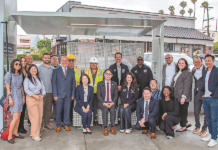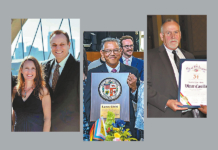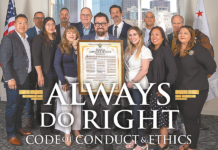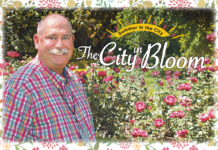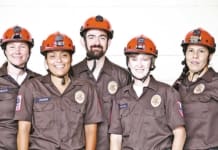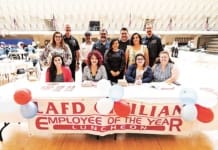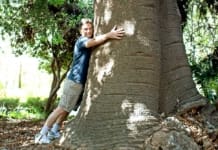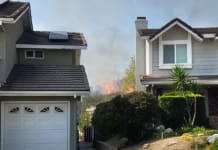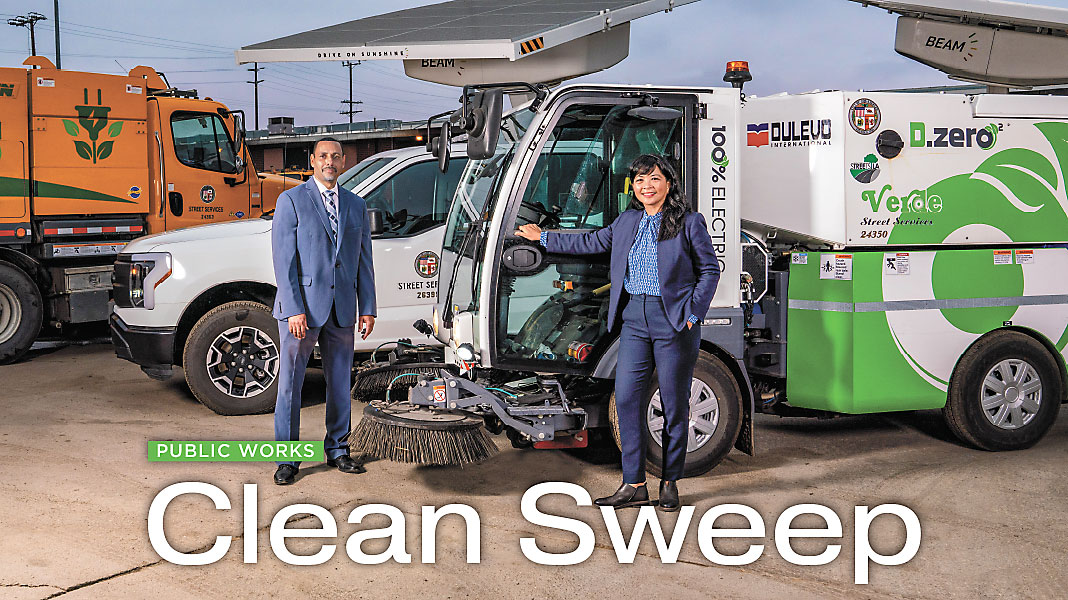
Photos by Summy Lam, Club COO;
and courtesy StreetsLA.
I
n the middle of the pandemic – Feb. 15, 2022 – StreetsLA introduced its Center for Green Innovation as part of LA’s growing response to the climate crisis.
The Club has been eager to catch up with the sustainability team to find out more details. Turns out the wait was worth it, as in the interim, the Center tested the country’s first fully electric street sweeper and evaluated its effectiveness for future purchase.
At introduction, the Center included the City’s first two hybrid-electric street sweepers and the infrastructure to support it, including a solar-powered charging station and maintenance, and a Roush clean tech hybrid Ford F-650 stake-bed truck.
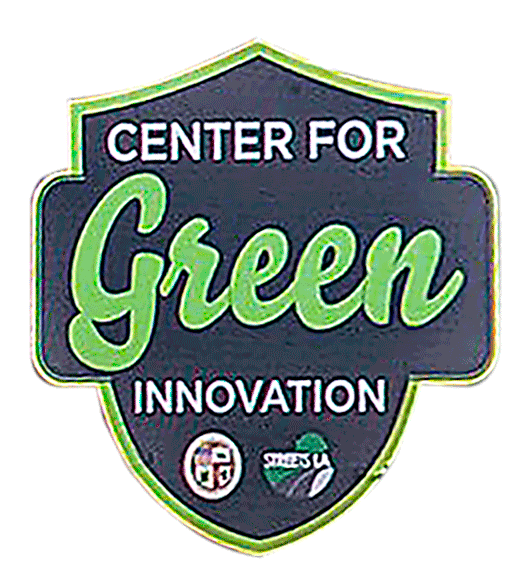 Under Mayor Karen Bass and the City Council, StreetsLA along with its Public Works partners and other City agencies continue to work on implementing and developing new initiatives and programs that are helping the City reduce its carbon footprint and address climate change.
Under Mayor Karen Bass and the City Council, StreetsLA along with its Public Works partners and other City agencies continue to work on implementing and developing new initiatives and programs that are helping the City reduce its carbon footprint and address climate change.
Since its inception, the Center has continued its progress, including more battery-electric vehicles, more battery electric tools, and many other initiatives. We promised our readers we would publish a more in-depth look of the Center’s first year, and that forms this month’s feature story.
The Club thanks Dan Halden, Paul Gomez, Stephanie Clements and Ana Tabuena-Ruddy for setting up our first visit to the center. •
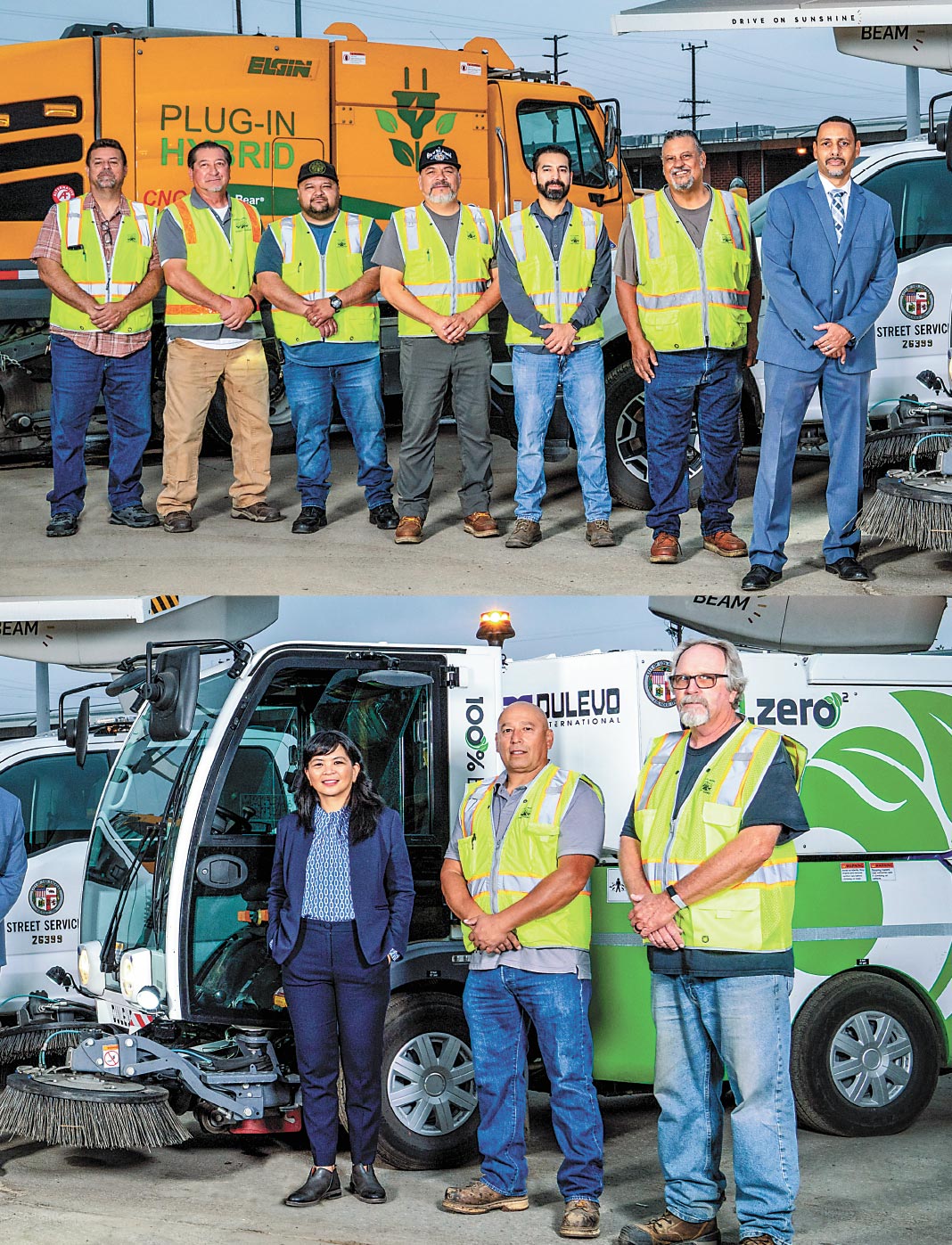

![]()
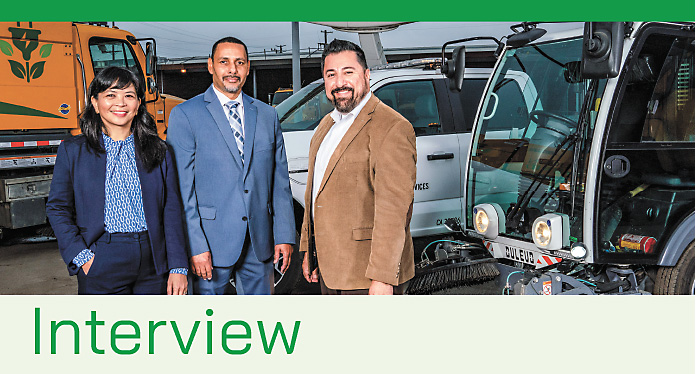
Sustainable Maintenance
On July 25, Club CEO Robert Larios and Alive! editor John Burnes interviewed four City employees who are managing StreetsLA’s’ sustainability efforts for project status updates to the EV Sweeper test and the overall Center for Green Innovation. The interview subjects were Ana Tabuena-Ruddy, Assistant Director and new Chief Sustainability Officer, StreetsLA, 11 years of City service; Michael Cox, Division Manager, Street Maintenance, 34 years, Club Member; Alex Lozano, Equipment Specialist, StreetsLA, 39 years, Club Member; and Brent Jones, Superintendent of Cleaning, StreetsLA, 26 years. • The interview was conducted via Zoom.
Thanks everyone for joining our chat today to update us on your current sustainability efforts at StreetsLA.

Ana Tabuena-Ruddy: Thank you for asking. By the way, I read Alive! all the time. My mother subscribes. When I visit her, that’s when I get caught up on the City news.
That’s great! Who’s your mom?
Ana: Isabelita Tabuena. She was an Analyst with the LAPD, and is now Retired.
Congratulations and thanks to her on her City career.
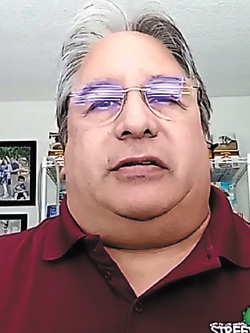
Alex Lozano: My favorite part of Alive! is reading Robert Larios’ recipes in there [as Chef Larios]. I’ve tried quite a few of them. They’re really good!
That’s music to my ears, for sure! I appreciate the support. I try to make those recipes easy to make, using ingredients that you would find in your own pantry. Sometimes recipes can be very elaborate. And then, for me to publish the recipe, it has to taste good. As long as it meets those three criteria, I feel I’ve made a successful recipe.
Alex: Keep it up, Robert. I really enjoy them. I’ve had some really good meals out of your recipes.
Thank you. Now we move on – tell us the path you took to your current position. Ana?
Ana: Sure. I started my career in the City as a Landscape Architect and worked my way up that classification, including as a Project Development and Interagency Coordination Manager, where I led my team in bringing more than $300 million in multi-benefit streetscape projects before I was selected for my current position.
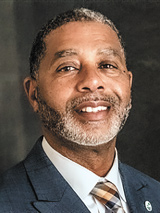
Michael?
Michael Cox: I started as a Maintenance Laborer, was promoted to a Street Services Worker, then to a Motor Sweeper Operator. And then into supervision and management.
Alex?
Alex: I started with the City as an Equipment Mechanic. I was hired first by the Police Dept. to work on patrol motorcycles. And then I moved on to the General Services, where I became a Sr. Equipment Mechanic and then an Equipment Specialist I. In 1986, I transferred to the Bureau of Street Services where I’ve been since 1989.
Brent?
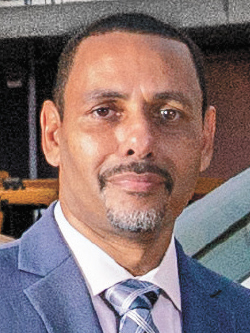
Brent Jones: I started as a Maintenance Laborer at Airports. I was promoted to Maintenance and Construction Helper, then from there I was promoted to Motor Sweeper Operator; from there to Heavy Equipment Operator; from there to Supervisor; and then on to my current position as a Superintendent.
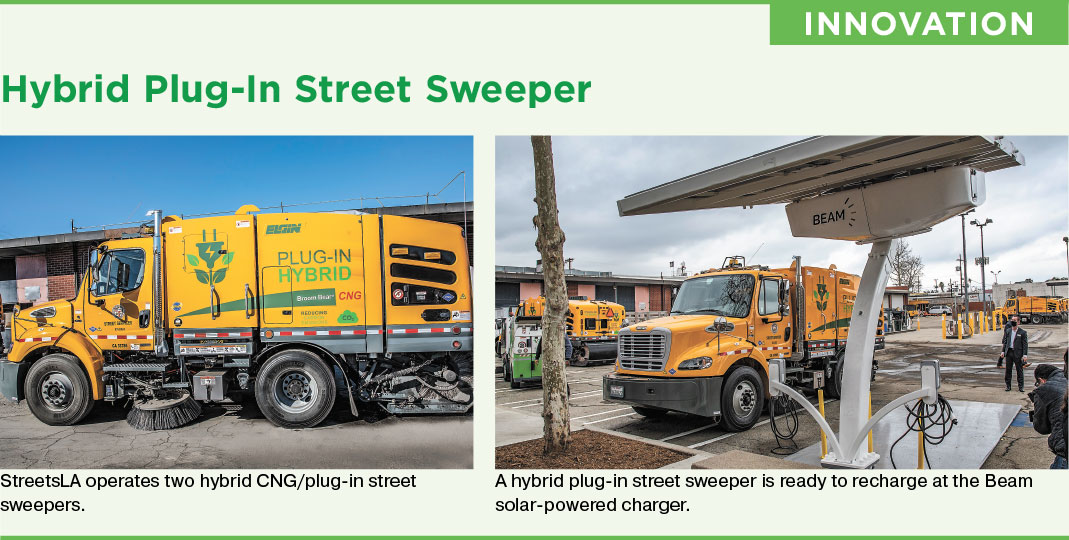
 The Electric Sweeper
The Electric Sweeper
Can you give us the status of the EV street sweeper that you’ve been testing? How’s that been going?
Alex: Let’s start a few years ago: We purchased two little Dulevo EV sweepers to sweep the bicycle lanes that the City’s been building. So we have a little bit of experience with the electric sweepers. Those are from Italy.
The EV sweeper was the brainchild of our Director, Keith Mozee. He convinced Broom Bear to develop and build an electric street sweeper, a full size electric street sweeper. We’re testing it now. There’s only one in existence. This is the prototype, although it’s put together so well, you’d swear it was a production unit. We’re in our week number two (at time of interview) of our prototype review. Right now they’re using telemetry to record the performance of the sweeper. They bring it in at night, and the manufacturer makes adjustments to help it perform a little better.
The first in the country?
Alex: There are one or two other electric sweepers that run on hydrogen fuel cells and so forth, but the one we’re testing is the only fully electric street sweeper.
Did you instigate this process, or did they approach you?
Alex: We’ve been buying Elgin Sweepers for quite a few years now. They run on compressed natural gas. But Keith really wanted to be the first to have a total battery electric sweeper; I give him the credit. He approached Broom Bear and asked them if they could develop it. They had developed the hybrid type of sweeper, and we purchased a couple of those so that we could get experience with the battery-operated broom and pump and water systems, and so forth. He kept working with them and encouraging them, and now they’ve got this full-battery electric sweeper. It’s on a totally different chassis but it’s got a lot of safety advantages that the old sweepers didn’t have.
Ana: Keith requested it from the manufacturer back in 2015.
Alex: Yes.
Has it been rotating it around the City? Or just on specified routes? How have you decided where to use it?
Brent: It’s been through various routes through our North Central and East Yards.
The main thing with these sweepers is to test and see how long that battery lasts. So far, it’s been pretty good.
Is there one central place to charge it, or do you have places to charge it throughout the City?
Brent: We’re using a charger at the yard where we’re keeping it. It makes it through the day with no problem. It will last a shift and a half, about 12 hours. It’s doing pretty good.
How are the numbers so far?
Brent: We’ve had it only for about a week [at the time of the interview], so we don’t really have a lot of numbers to report, but the battery is lasting for the whole shift, and we’re happy with that.
Sounds like you like its possibilities.
Brent: Yeah. So far, we’re happy with it. It’s living up to our standards from what we expected it to do.
Alex: The manufacturer is still gathering data with their telemetry to report on how many tons, say, of CO2 that the sweeper saved and also how much particulate matter has been saved since it’s a battery electric versus diesel. It’s in the tons, maybe a couple of tons of CO2.
Wow.
Alex: If we were to use this over the span of a year, it could get into the hundreds of tons of CO2 saved, especially the particulate exhaust that comes out of the exhaust pipe of an engine. Even a clean burning engine like CNG has got some unburned hydrocarbons, some carbon monoxide, some oxides of nitrogen NOX. This sweeper doesn’t produce any of that. It’s pure battery electric. So whatever pollutants it generates, it’s generating it at the power plant, not in the battery. It has no tailpipe.
How many sweepers are in your fleet, by the way?
Alex: Approximately 135.
Wow, it’s impressive to think how many tons of CO2 would be saved if you multiplied that one vehicle over 135 in the fleet.
Alex: Yes!
Ana: It will be interesting to see as the weather gets hotter and someone’s using air conditioning in the cab, how much that affects the length of the charge.
Alex: Yes. It has air conditioning. But this particular battery pack is twice the size of a normal battery pack. They’ve really put in a lot of extended range on this sweeper.
Michael: With the weather we’ve had in the last couple weeks, they’re already using the AC on it.
Did you have to train drivers specially to use it?
Michael: The biggest thing in training involves charging it. But other than that, the operation is just as normal as our other sweepers, and no change in the staffing.
The only real training we have done is the charging aspect – showing them how to hook up the charger, when to charge it, and so forth.
Brent: If you look at the EV sweeper and compare to our CNG sweepers, everything from the cab back is identical. The sweeping aspect is identical, so they didn’t have to learn anything really on that part of it. It’s just the charging.
Alex: The street sweeper itself is very familiar to our sweeper operators. They just have to be mindful that they’re not running a diesel engine or a natural gas engine. They have to remember to plug in at the end of their shift, and check the battery level before they leave in the morning to go sweep again.
Are there other cities looking at the EV sweeper? Are they anxious to hear your data and what you’ve found?
Alex: The City of San Diego tends to follow us very closely with the technology that we’re using.
Is there a difference in noise level between the EV versus the old sweepers?
Brent: The only noise you hear from the electric sweeper – and that’s when it’s sweeping – is the brooms on the ground. You do hear a slight hum like most electric vehicles have, but other than that, it’s very quiet other than the brooms turning on the ground.
Pretty incredible.
Update: At a press conference on August 10, City Councilmember Bob Blumenfield and city officials announced the purchase of the electric sweeper. StreetsLA is appreciative of the work and support of the Mayor’s Office, City Council, and partner agencies in securing the sweeper as City continues greening its fleet.
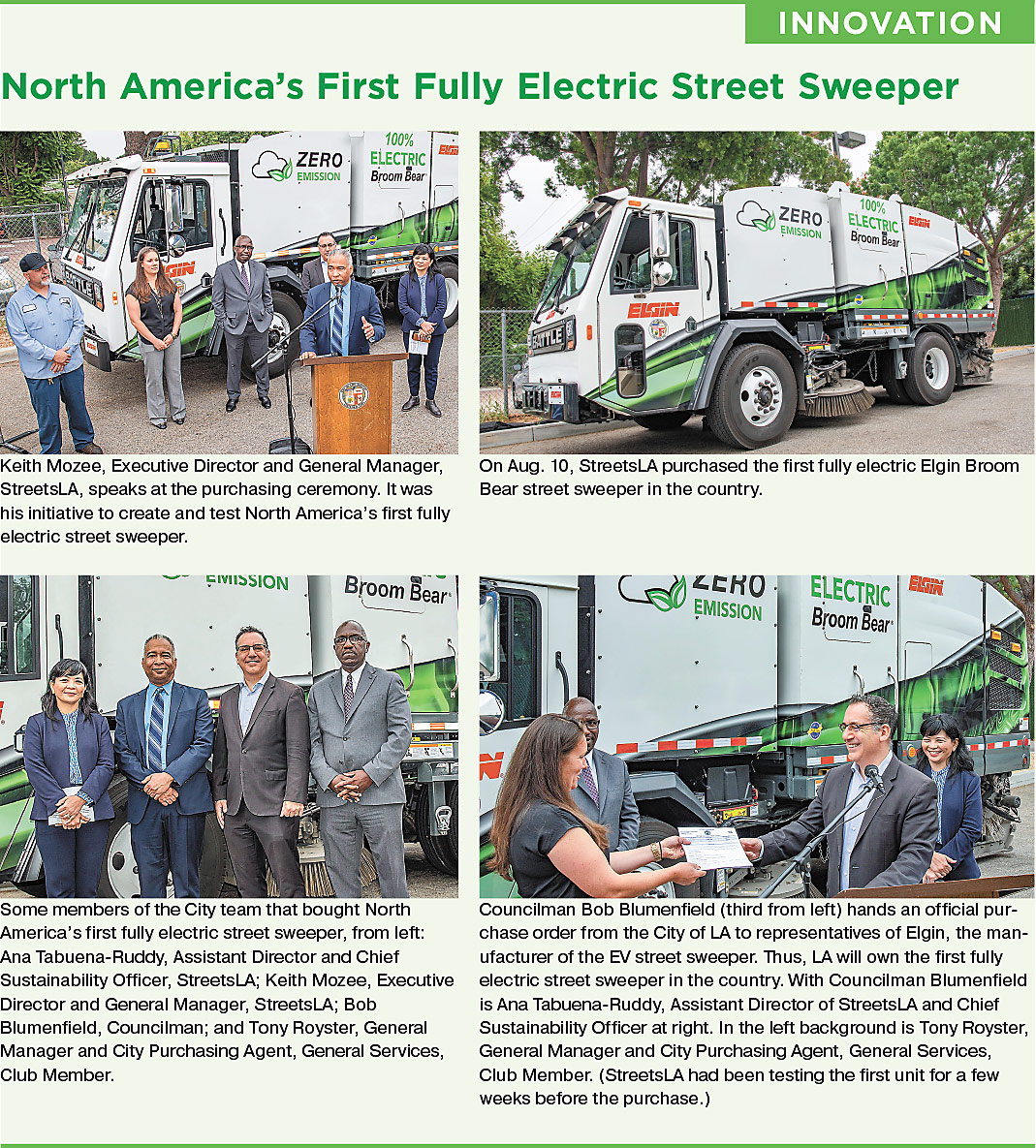
 Centering on the Center
Centering on the Center
In the middle of the pandemic, StreetsLA created the Center for Green Innovation at the North Hollywood Yard. It looked like you were centering a lot of your sustainability efforts into that office. Can you update us on the Center?
Ana: Sure, The Center for Green Innovation is a hub where we can test things before we deploy them throughout our different yards. We use information or lessons learned in that yard and then try to replicate them in our other yards. The Center was motivated by former Mayor Eric Garcetti and his Green New Deal.
One thing that we started over there is the Path to Zero Emissions. We’re also looking into other things like Greening Our Yards, et cetera. So for that yard, we installed a Beam charging station, so I don’t know if you guys are familiar with that one. It’s a transportable off-grid EV charging station. If a location does not have existing electrical infrastructure to be able to handle a charging station, we are able to use the Beam equipment because it’s transportable. We can move it around to different yards if we need to. Our operations folks gave us some feedback on it and they said that it’s working well, so because of that we just recently placed an order for 10 more Beam systems, and we’re distributing that all over our different yards – we’re picking locations where there’s no existing electrical infrastructure.
How does the Beam system work?
Ana: It’s solar-powered. If a yard currently does not have existing infrastructure, we can use the Beam for that purpose. Let’s pretend all our fleet is now EVs; we would have to find a way to charge our vehicles. Once we have all the yards upgraded to have infrastructure, we can still use it for emergency situations if the grid was to go down for example.
Right.
Ana: We would be able to continue functioning. The Beam will serve its purpose more than just as a temporary solution while we upgrade our yards.
When do you expect to see the Beam systems you’ve ordered?
Ana: There’s a three- to four-month lead time before we’re going to see them. That will perfectly align with the delivery of the 16 new EV trucks that we’ve ordered.
What are the 16 new EV vehicles that are coming in?
Alex: Ford F150 Lightning pickups. We have one already. We were the first department in the City to have it. We’ve got 16 more of those on order. We also have a flatbed truck for tree planting that should be delivered in another couple of months. I’ve got a battery electric tree trimming truck on order, too.
Ana: Yes.
Alex: To trim the trees. We’re really starting to get the ball rolling here. Because of COVID-19, there are still a lot of supply chain problems and issues. Trying to get little parts – relays and different components to complete the trucks and to complete the order – has been an issue for us. But we’re working through it and exercising patience.
Ana: 10 of the 16 EV trucks that Alex mentioned are for Street Maintenance, and the rest are for Urban Forestry. The flatbed and the tree trimming trucks are also for Urban Forestry Division.
There’s no going back. This is the way.
Ana: Definitely.
 Other Initiatives
Other Initiatives
What other initiatives are centered in the Center for Green Innovation?
Ana: We have five innovations and sustainability focuses. The first being Path to Zero Emissions – upgrading our fleets and upgrading our tools and equipment so that they’re battery charged. We’re looking at our gas leaf blowers, for example and other tools.
And then there’s Circular Economy, where we’re looking into recycling materials and reusing them to give them another life. We also completed a white paper feasibility study on converting tree waste into a biochar product that can be used as soil amendment for better tree health. It could also be used for capturing stormwater pollutants and potentially – though this needs more investigation and study – as a bitumen additive for asphalt, so that it can withstand extreme heat temperatures. So those are our circular economy efforts.
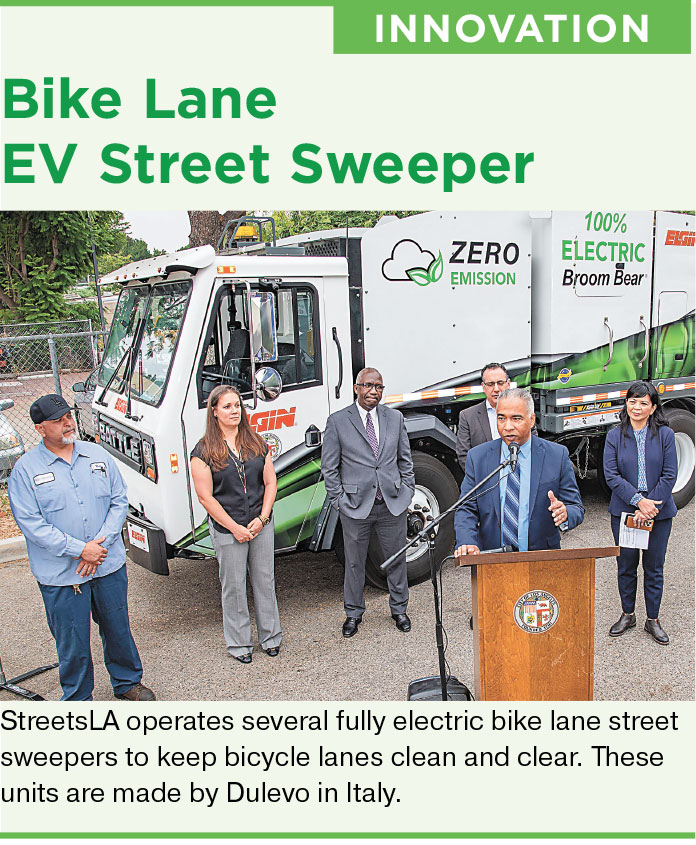
There’s Greening Our Yards, an initiative to upgrade yards to support sustainability efforts. Digital Everywhere is our initiative to update protocols and processes to be computerized so we’re all digitally connected and be more efficient. And then Sustainable Streetscapes is our focus on nature-based solutions like increasing biodiversity, with the goal of converting 14 million square feet of medians in the City into California-native plantings and installing efficient irrigation systems, while supporting pedestrian and bike-friendly access. Those are all our innovation and sustainability initiatives.
Is there any industry that’s moving faster? It seems like municipal departments like LA’s are leaders in a lot of this technology that is really happening. I don’t think our municipal departments are getting nearly enough headlines for the work that you’re doing.
Ana: We have a great team of folks at StreetsLA, and you’re getting a glimpse here in this interview. Everyone’s moving the needle in their own divisions, and I think StreetsLA is leading that.
 Challenges and Mission
Challenges and Mission
What are your challeng es in trying to bring more sustainability to the City of LA?
Ana: It always comes down to two things. Funding and the personnel to deliver the work. We try to work with what we have and get creative. For this fiscal year, we are grateful to Mayor Bass and City Council for funding the purchase of our EVs.
Alex: It’s like what Ana said. We try to spend smart. We try not to go down too many dead-end alleys by buying something that hasn’t been proven or it might not work out for us. There are a lot of things we could buy just to try it out, but we try not to do that. We try to plan ahead and try to think things through, formulate a plan and then execute it and spend the funds wisely.
Ana: StreetsLA is a first responder. We always have to keep in mind that, as first responders, we may have to be available 24/7. The charging technology is not quite there yet where we can charge in 10 minutes and then get a truck out to an emergency site. As technology tries to keep up, we’re ready to move forward, but technology still needs to catch up with the type of operations that we have.
How does the Center address Public Works’ mission for sustainability and promise to grow the City’s sustainability abilities?
Ana: I think other cities look to us for innovation, and our vendors really take it to heart when we give them feedback, and respond by making changes to their products. It’s important that we do things very carefully and thoughtfully in moving forward with testing and development. We are tasked with moving things forward, and we do.
Are there any initiatives that you’re looking at incorporating down the road, so to speak?
Ana: We’re pursuing a variety of big and small initiatives. We’re looking at converting our existing turf medians that are water guzzlers into biodiverse California-native medians. We’re looking into technology for efficient irrigation systems. And to continue updating our fleets into EVs. We have much equipment that still needs conversion, so we continue to work on that. Another effort is looking at piloting e-bikes with a small cargo hold and a roadway scanner for bike lane inspections. An inspector can bring barricades in the cargo for instant implementation, as needed. We’re also looking at using sustainable materials to replace existing gear and tools, where possible. And here’s a simple one – we just implemented a virtual business card to reduce paper waste, so that now people can just scan a QR code to have all our information there; it automatically goes into someone’s contact list. Simple things like that.
Another one – this is dreaming big, which I mentioned earlier, is the biochar white paper feasibility study. We just shared that information with the Departmental Chief Sustainability Officers. There is interest with the Bureau of Engineering because they’re working on a decarbonization study. There’s also interest within Sanitation because that could be used for stormwater pollutants and odor removal.
Overall, it’s important that our Bureau continues to deliver our services without interruption while still looking at innovations. There won’t be any delay that affects our services just because we’re testing new things out.
 Favorite Programs
Favorite Programs
What’s been your favorite part of the sustainability initiatives so far?
Ana: I really like hearing feedback from our crews who are testing the equipment. They mention how quiet they are. If they’re testing some of their tools, they aren’t disturbing the public. I like that. That’s just one thing.
Michael: Getting the feedback from the crews or the individuals working on a project or product. It shows they’re really thinking about what we’re trying to do and they’re not just treating it casually.
Brent: It’s knowing that we, as the City of Los Angeles, are the innovators. We are the City that everybody in the world looks at to be the first ones to do something. They look at us as testers. And then they usually follow suit. That makes me feel good to know that we are the ones that everyone else is looking up to.
Alex: The most fun part for me is to see people, who are set in their ways, seeing new ways. For instance, the chainsaws we use to trim the trees. The old chainsaws required the user to pull a cord to start it, and it would make a wing-ding-ding-ding kind of a noise. We bought some battery electric chainsaws, and the guys were looking at them saying, “These are never going to work.” The first couple we tried didn’t work very well. But now we’ve found one that works terrific, and they love them because they’re quiet and cut really well. When the battery starts to get low, they just change batteries and then they’re ready to go again. They take the depleted battery and they plug it in right there at their truck. The users don’t have to mix gasoline and oil. They don’t have to deal with any of that. It’s a very-high-quality chainsaw and it’s quiet. Like Ana says, we’re not disturbing the public anymore. That’s just one example. We also have an electric breaker, like a jackhammer. You know what those sound like. We’ve got one that’s battery electric and it’s quiet and powerful. It improves the lives of the people of Los Angeles, and that’s really ultimately what we’re here to do.
 A Passion for Progress
A Passion for Progress
Well, here’s the signature Alive! interview question: What do you love about what you do?
Ana: I enjoy bringing a systems thinking approach to my work – making sense of the whole instead of just its parts. Many people think the beginning and end of a project, like the groundbreaking or the ribbon-cutting, is the goal. But what comes after – the daily operations of maintenance and repair — is really the ultimate goal. These daily operations are so critical for the City; without them, nothing else can exist. Maintenance is sustainability.
I’m also fascinated by our role as first responders. We really play an important role.
And that StreetsLA folks are just wonderful people to work with. When we need to triage something, everybody gathers together. It’s teamwork. We experienced that at the beginning of this year when we had the storms with all the potholes. Everybody across divisions banded together and helped us out.
Brent: It’s pretty simple. It goes back to my days when I was in Resurfacing. I like to see a beginning and an end. So when you get to a street in resurfacing, you see a bad street and then when you’re done, it’s a brand new street. As a Superintendent over Cleaning, I see a dirty street, and when the sweeper passes by, it’s nice and clean. I like that aspect of it.
And then also what Ana just said – I like the teamwork and the fact that I can call another division if I need assistance with something, and they can call me if they need assistance. If they need a sweeper, they can call me and I can provide assistance for them.
Michael: I enjoy working with people and meeting people. My day-to-day interactions with my colleagues and other agencies have been great for me. I’m a people person. I know Brent’s laughing because he always says that I’m the one who’s always shaking hands and kissing babies.
I’ve got almost 35 years of service, and I love seeing how things have evolved and changed and improved. We’ve gotten a lot better in some areas. I was a Sweeper for many years. To go into a route and see that it’s clean, I love knowing I had something to do with that. And even now, as I ride through the City, I see potholes being repaired that I physically requested. It’s fixed. I enjoy seeing that and knowing that I’m part of it.
Thank you all for taking time today to update us about your contributions to sustainability in LA.
Ana: Thank you for making this such a pleasant experience for all of us.
Brent: Take care, you guys.
Michael: Take care.
Brent: Bye, everybody. •
|
BEHIND THE SCENES
Photographer and Club COO Summy Lam photographs Brent Jones, Superintendent of Cleaning, StreetsLA; and Ana Tabuena-Ruddy, Assistant Director and Chief Sustainability Officer, StreetsLA; at the StreetsLA North Hollywood Yard. |




